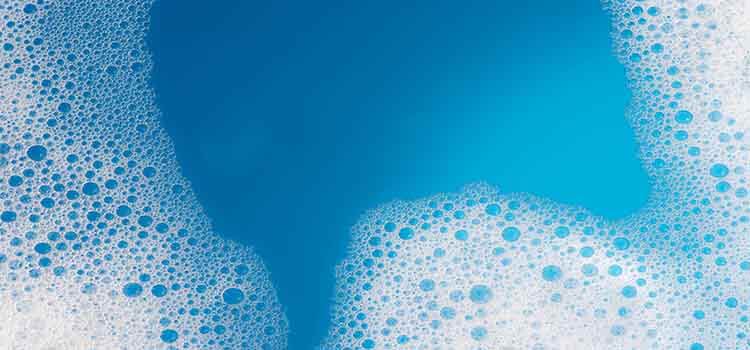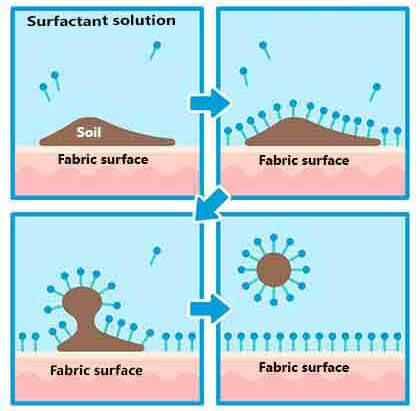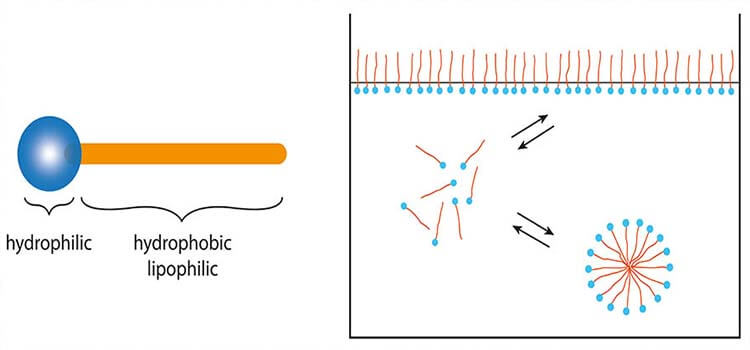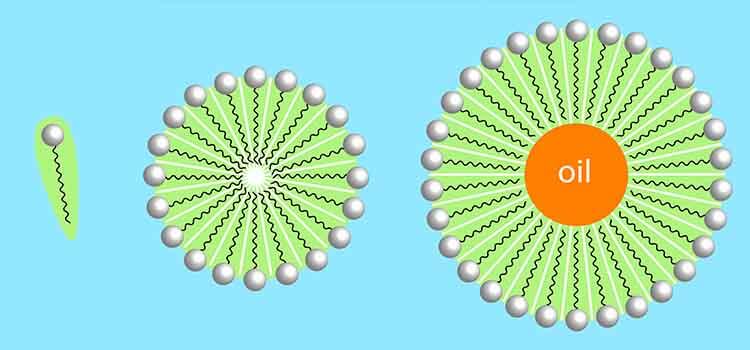Nonionic surfactant refers to the surfactant molecules, which do not undergo ionization when being dissolved in water. The Nonionic surfactant are not in the ionic state in the solution, thereby having high stability and being less susceptible to the effect of strong electrolyte inorganic salts as well as acid and alkalis. Nonionic surfactants have excellent compatibility with other types of surfactants and have excellent solubility (which vary depending on different structures, HLB etc) in both water and organic solvents.

Nonionic surfactants have covalently bonded oxygen-containing hydrophilic groups, which are bonded to hydrophobic parent structures. These Nonionic surfactants, are not ionized in water, and contain both hydrophilic groups (e.g. oxyethylene-CH2CH2O-, ether groups, hydroxyl group -OH or -CONH2 amide group, etc.) and lipophilic group (e.g., hydrocarbons which can be natural fatty alcohols or synthetic alcohols, acids or glyceryl esters/oils). The water-solubility of the oxygen groups is the result of hydrogen bonding. Hydrogen bonding decreases with increasing temperature, and the water solubility of Nonionic surfactants therefore decreases with increasing temperature. This result in formation of a milky/cloudy emulsion called the cloud point of surfactants. This property is very essential for determining the optimum use of Nonionic surfactant in formulations at elevated temperature especially in cleaning formulations like detergents, CIP etc.

As discussed above Nonionic surfactants have a unique property called a cloud point. The cloud point is the temperature at which the Nonionic surfactant begins to separate from the cleaning solution, called phase separation. When this occurs, the cleaning solution becomes cloudy. This cloud point is therefore considered the temperature for optimal detergency. For low foaming cleaners, optimal detergency is at the cloud point; for foaming cleaners optimal detergency is either just below the cloud point or at the start of the cloud point. The agitation of low foaming cleaners is sufficient to prevent phase separation. The temperature of the cloud point depends upon the ratio of the hydrophobic and hydrophilic portions of the Nonionic surfactant. Some cloud points are at room temperature while others are very high. Some Nonionic surfactants don’t have a cloud point because they have a very high ratio of hydrophilic to hydrophobic moieties.
Nonionic surfactants are less sensitive to water hardness than anionic surfactants, and they foam less strongly. The differences between the individual types of Nonionic surfactants are slight, and the choice is primarily governed having regard to the costs of special properties (e.g., effectiveness and efficiency, toxicity, dermatological compatibility, biodegradability) or permission for use in food. In areas with hard water (high mineral content), Nonionic surfactants are more heavily marketed, as they are less likely to form a soap scum. The Nonionic surfactants are less likely to cause skin irritation, but this is associated with a less potent cleaning ability. Most cleaning products are manufactured as a blend of anionic and Nonionic surfactants to balance out the cleaning potential with the risk of skin irritation.

The aqueous solution of Nonionic surfactants has poor foaming capability with the foam being not stable as well. This is due to that each molecule of the Nonionic surfactant has relatively large surface area and the interface being in uncharged foam. Polyoxyethylene has long chain and uniform molecular weight distribution. The lipophilic group has long chain and also contains branched chain. The presence of the polyoxyethylene -polyoxypropylene copolymer both has a great impact on the foaming of the Nonionic surfactants. Owing to the presence of the polar portion and non-polar portions existing in their molecular structure, they have large surface activity. Such kind of active agents can be divided into the ester type (e.g. polyoxyethylene fatty acid esters, sorbitan fatty acid esters anhydrides), ether type (e.g., polyoxyethylene alkyl ether, polyoxyethylene alkyl phenol ether), amine type (such as polyoxyethylene fatty amine), amide type (such as polyoxyethylene alkyl amide) and mixing type (such as sorbitol anhydride fatty acid esters, polyoxyethylene ether). In the field of oiling, Nonionic surfactants are mainly used in foaming, emulsifying, anti-wax, anti-corrosion, retarder, production increase of oil wells, intensified injection of injection wells as well as improving oil recovery and so on.
Role of Nonionic surfactants In Detergency Applications

Nonionic surfactants are neutral, they do not have any charge on their hydrophilic end. Therefore, Nonionic surfactants are very good at emulsifying oils and are better than anionic surfactants at removing organic soils/grease. The combination of Nonionic and anionic surfactants are frequently used together to create dual-action, multi-purpose cleaners that can not only lift and suspend particulate soils, but also emulsify oily soils. Most cleaning products contain Nonionic surfactants (emulsifiers and detergents), anionic surfactants, or a mixture of both in their composition.
Certain Nonionic surfactants can be non-foaming or low-foaming. This makes them a good choice as a ingredient in low-foaming detergents. Examples of some common nonionic surfactants include ethoxylates, alkoxylates, and cocamides.
If anionic surfactants are the most popular, Nonionic surfactants are a close second, widely used in a range of cleaning, personal care, and disinfectant products as well as industrial processes. The most common anionic surfactants are: Cocamide monoethanolamine (Cocamide MEA), Cocamide diethanolamine (Cocamide DEA), Fatty alcohol ethoxylates, Amine oxides, Sulfoxides. The group of Nonionic surfactants represents the second, by volume, most relevant group of surfactants used in cleaning products. Its most important representatives are by far the alcohol ethoxylates (AE) while other groups like alcohol alkoxylates (EO/PO adducts), fatty acid alkanolamides, alkylamine oxides and alkyl polyglucosides (APG) play a less ubiquitous role.
Role of Nonionic surfactants in drug delivery systems
Liposomes are vesicles made of natural or synthetic phospholipids whereas those made of Nonionic surfactants (e.g. alkyl ethers and alkyl esters) and cholesterol constitute a Nonionic surfactant vesicular system called niosomes. Nonionic surfactants can improve the solubility of some poorly soluble drugs and formulation in niosomes can improve the bioavailability of these drugs.
Nonionic surfactants, consisting of a hydrophilic head group and a hydrophobic tail, used in the preparation of niosomes, carry no charge and are relatively non-toxic. The hydrophobic moiety of the Nonionic surfactant may be alkyl, fluoroalkyl, or steroidal in nature. According to their characteristics, the Nonionic surfactants can form structures in solution without charge in their polar heads. The Nonionic amphiphiles used in niosomes are classified in four categories: alkyl esters, alkyl amides, alkyl ethers, and esters of fatty acids.
The number of hydrophobic moieties at present are limited, but a wide variety of hydrophilic head groups are available in vesicle-forming surfactants. Various types of Nonionic surfactants, such as polyglycerol alkyl ethers, glucosyl dialkyl ethers, crownethers, ester-linked surfactants, polyoxyethylene alkyl ethers, Brij, Spans (sorbitan esters) and Tweens (Polysorbates), used for the preparation of niosomes fall into the GRAS category and are mild to use. Niosomes are generally composed of Nonionic surfactants, cholesterol and/or dicetyl phosphate (DCP).
Use in Composites
The hydrophilic groups and lipophilic groups of Nonionic surfactants may respectively interact with the inorganic filler and polymer matrix material to strengthen the links between them two, thus improving the compatibility between the two and playing an effect on plasticizing and lubrication of the flexible carbon between two polar groups. Meanwhile, it can endow the system with flexibility and mobility, reducing the viscosity of the system, and thereby improving the processing properties of the composites. For example, Nonionic surfactants like BYK-110 (solution of a copolymer with acidic groups) Tween-80 (Polysorbate 80) and Nonidet-P40 (nonylphenoxypolyethoxyethanol) were tested as a modifiers in the dispersion of multiwall carbon nanotubes (MWCNTs) in the epoxy matrix. The performance of Nonidet-P40 in improving the thermomechanical properties of the final epoxy resin and achieving overall dispersion of MWCNTs was found to be the best.
Polymer nanocomposites in the nanotechnology sector have been manufactured by using natural, biosynthetic, and synthetic or synthetic biodegradable polymers with nanofillers. These nanofillers of polymer nanocomposites are normally modified with Nonionic surfactant, anionic surfactant, and cationic surfactants for increasing the mechanico-thermal properties of the nanocomposites for a variety of applications.
